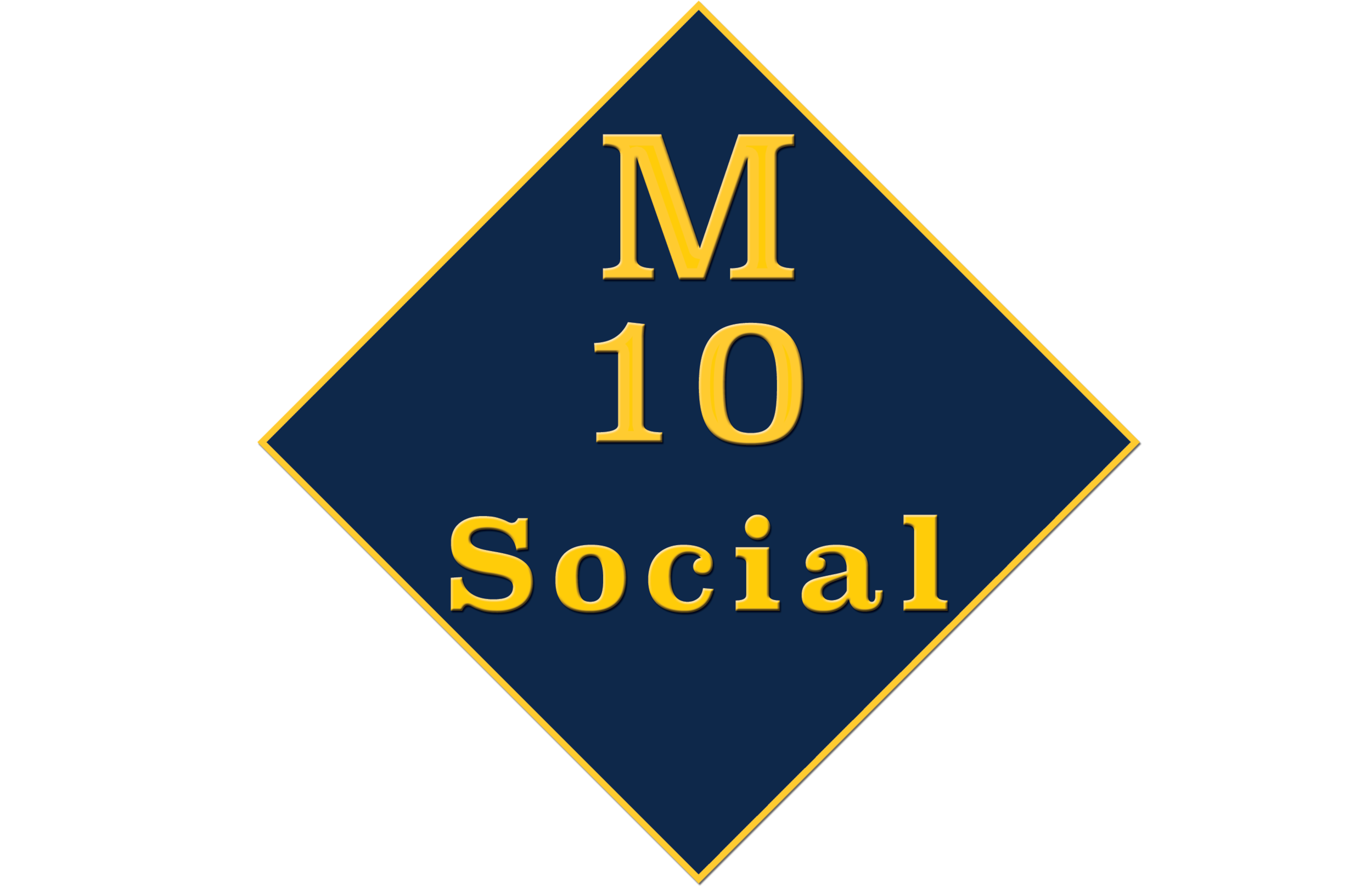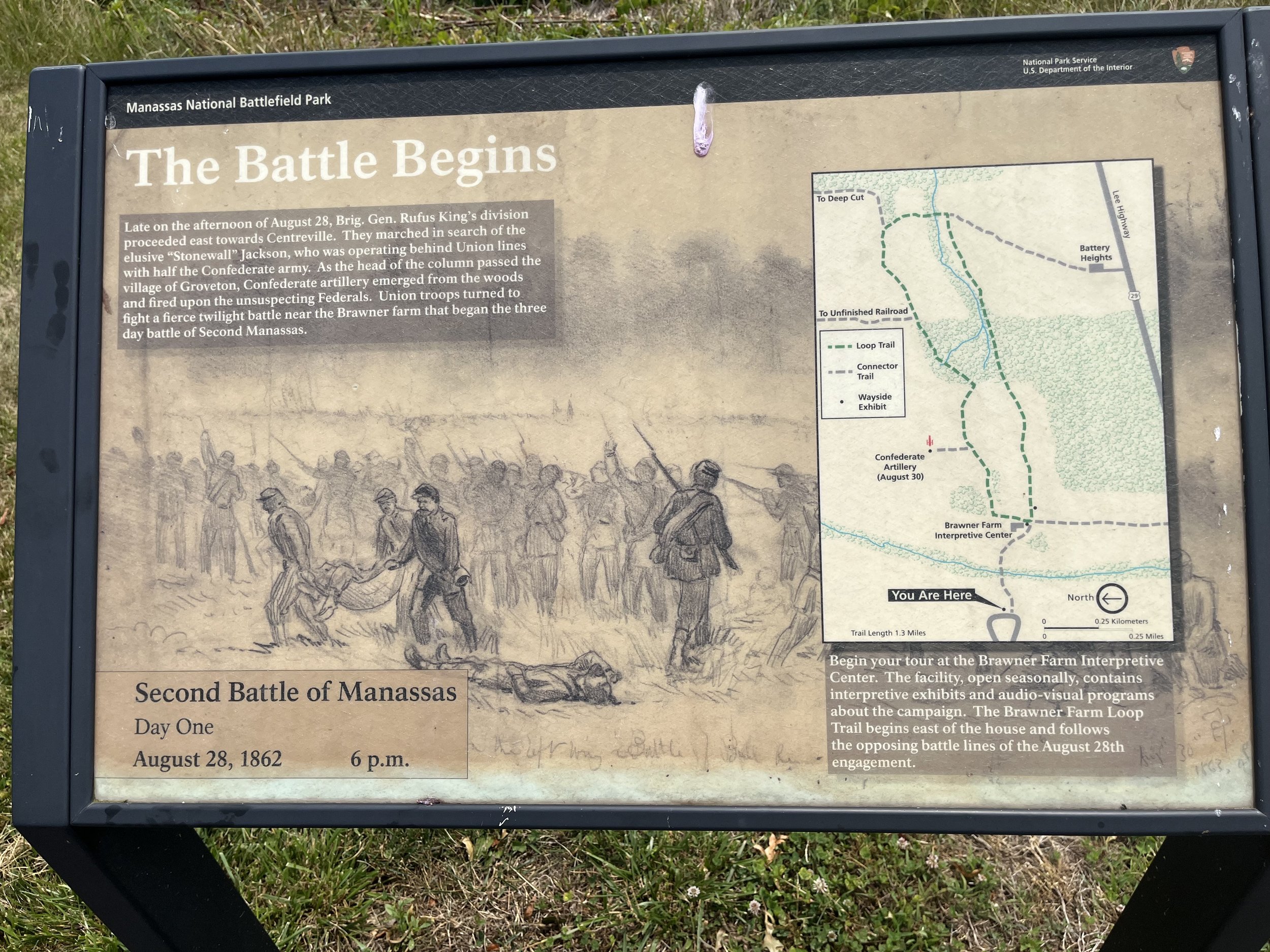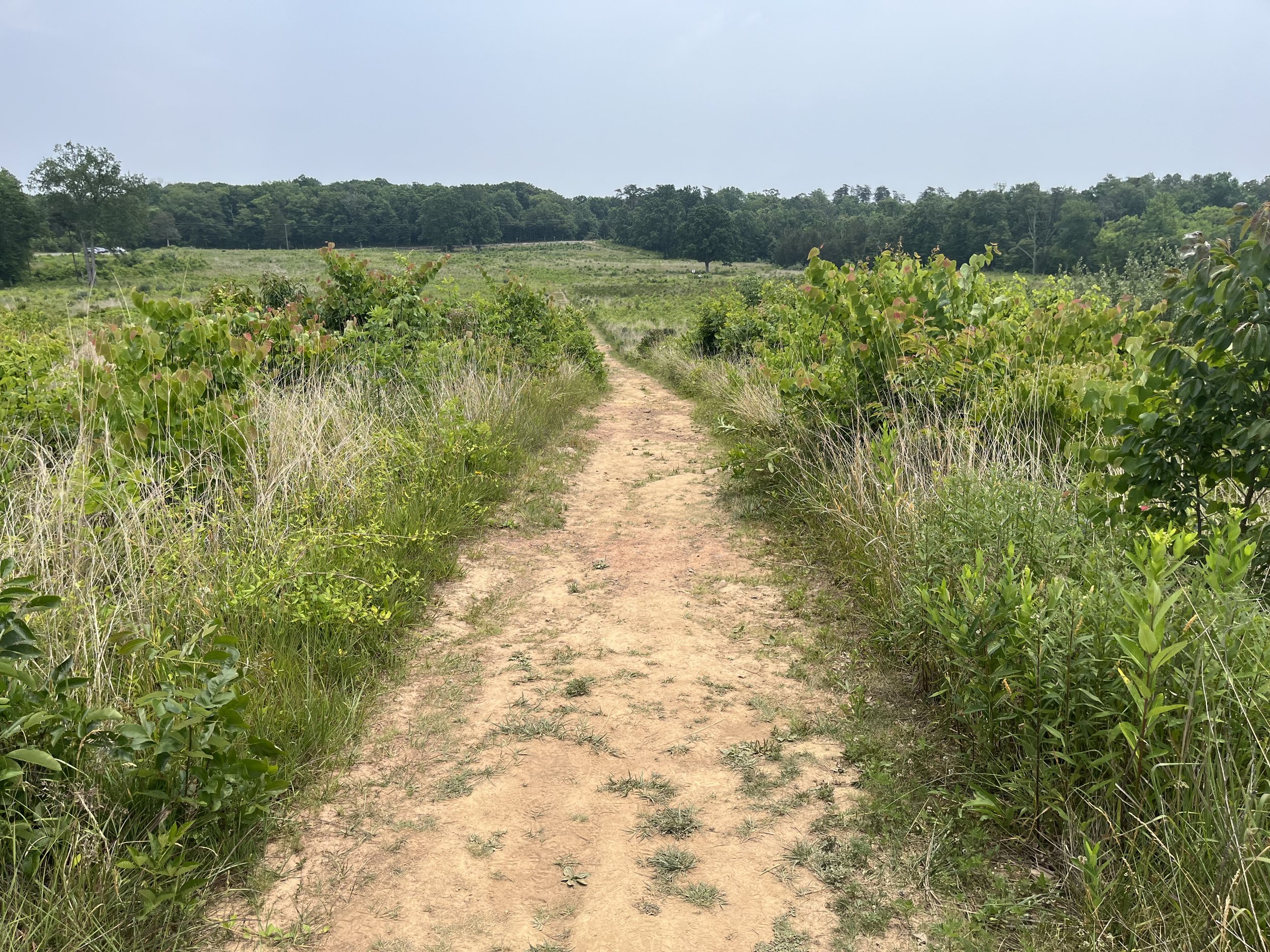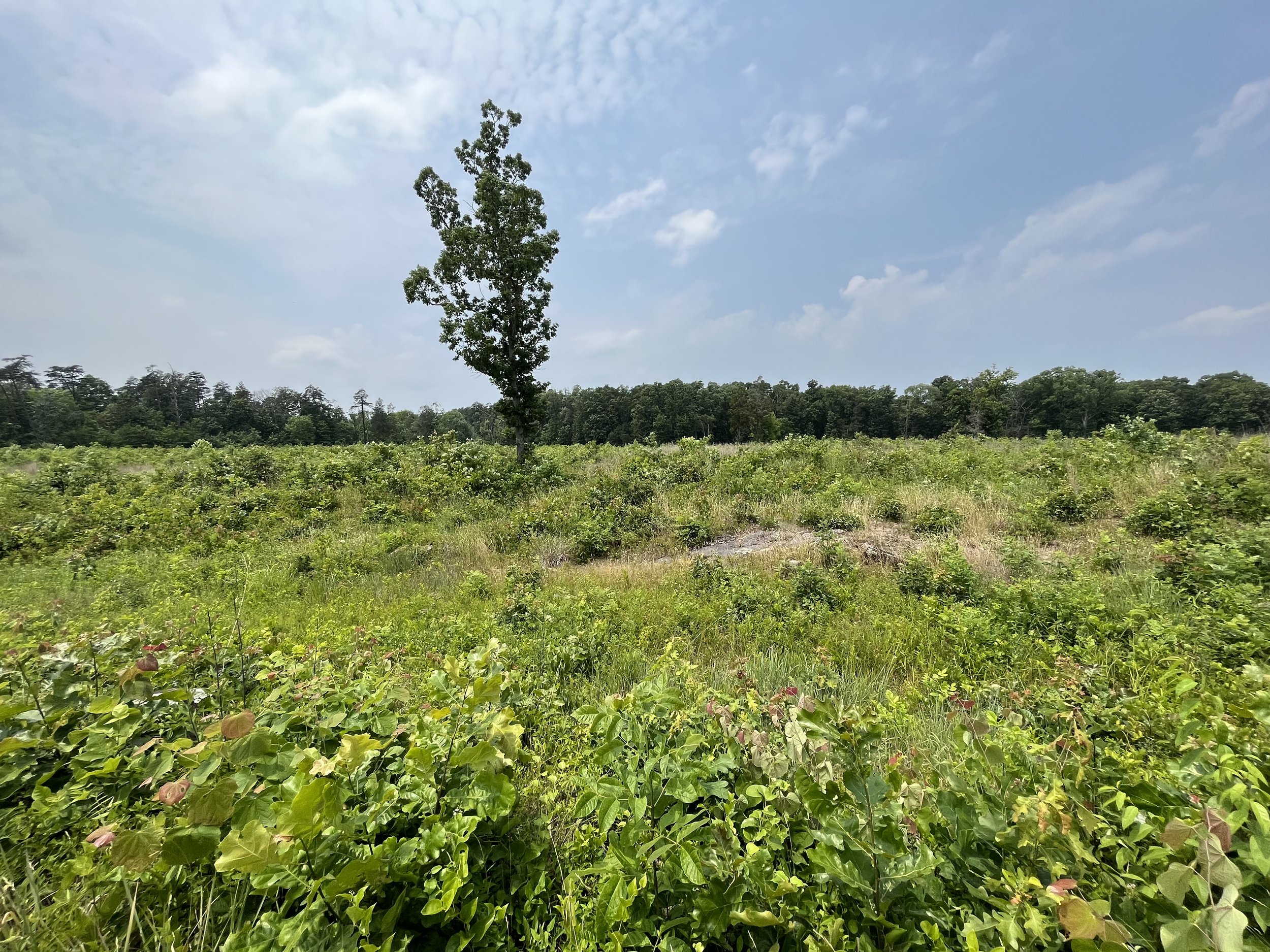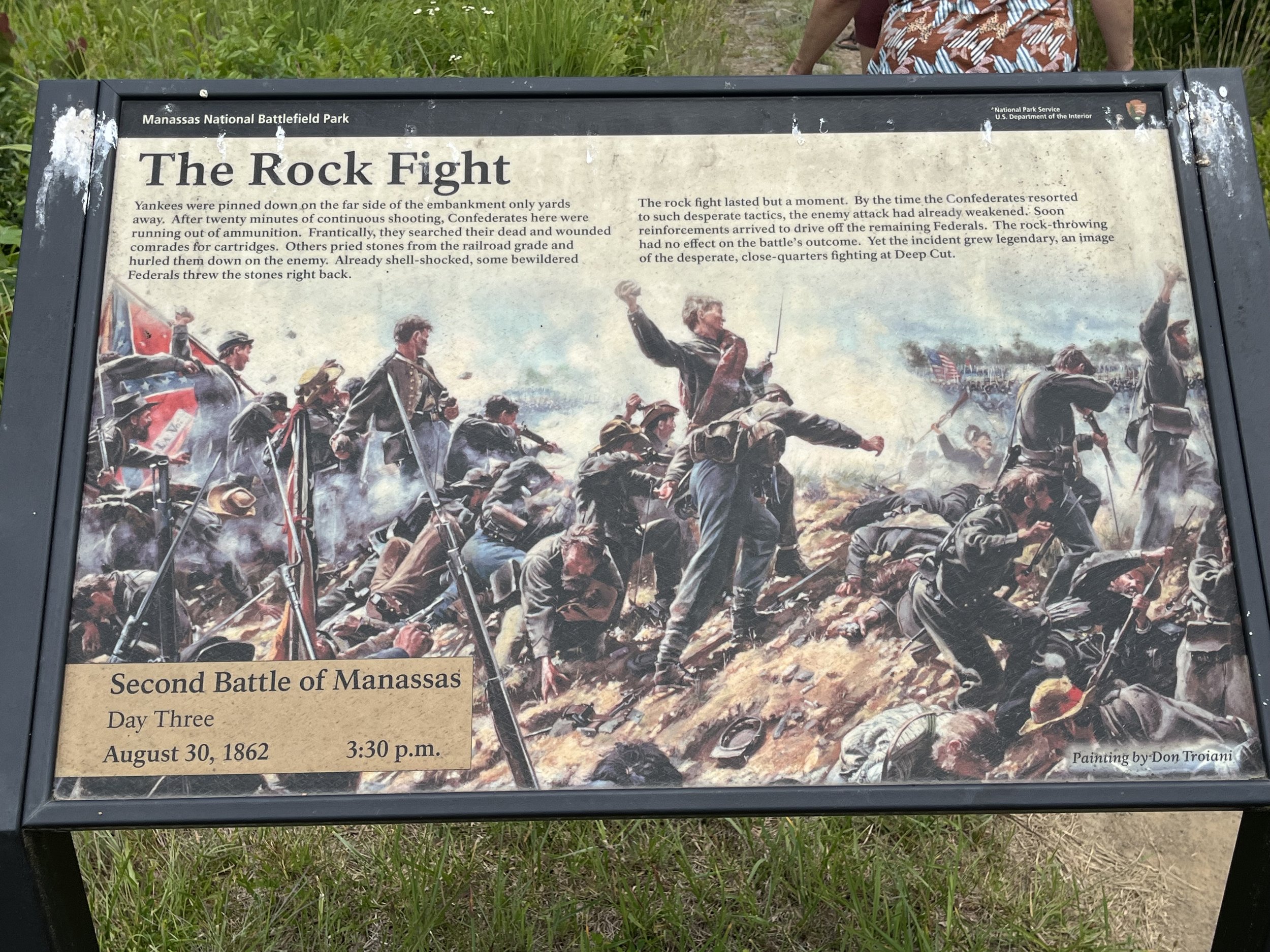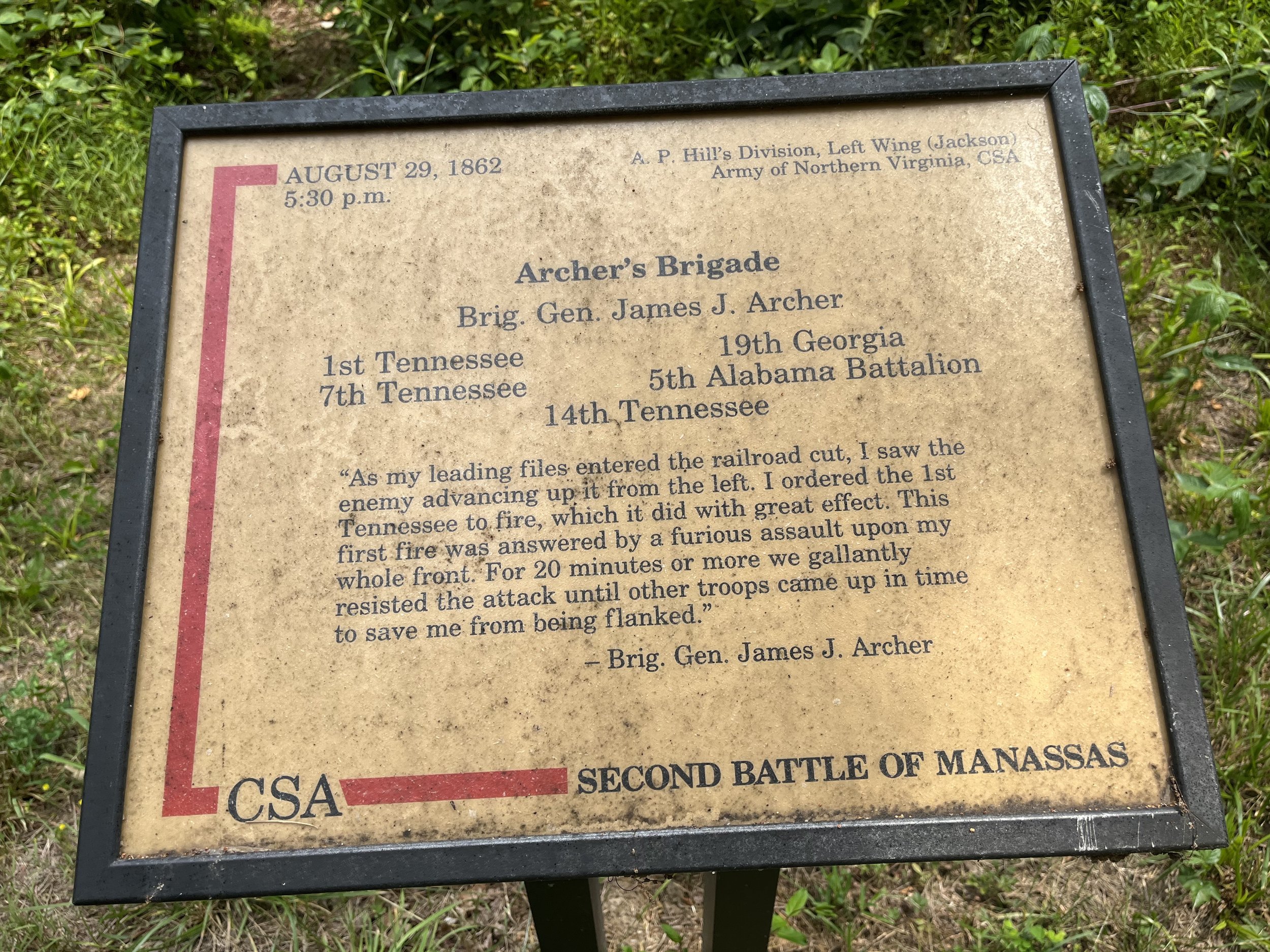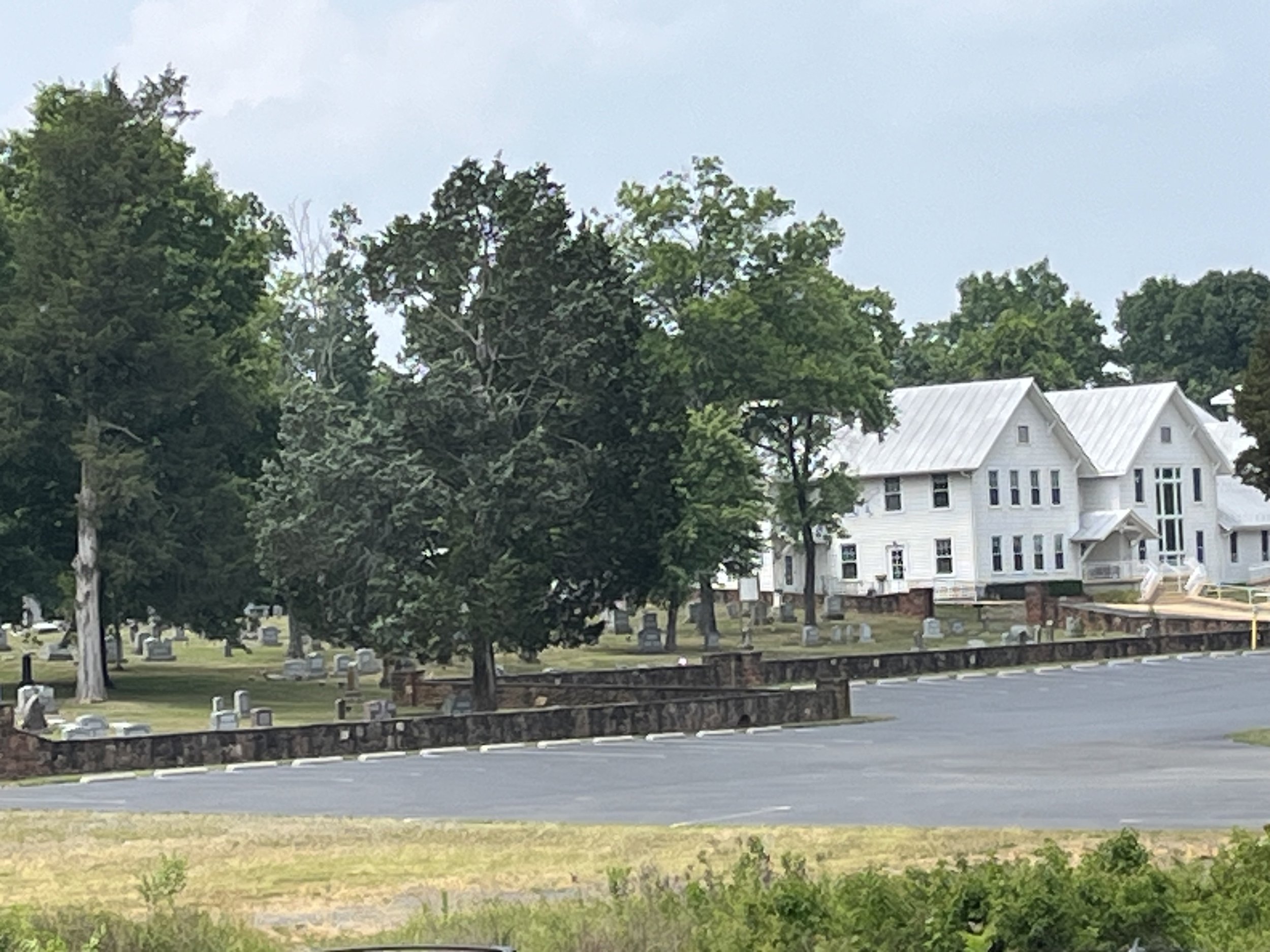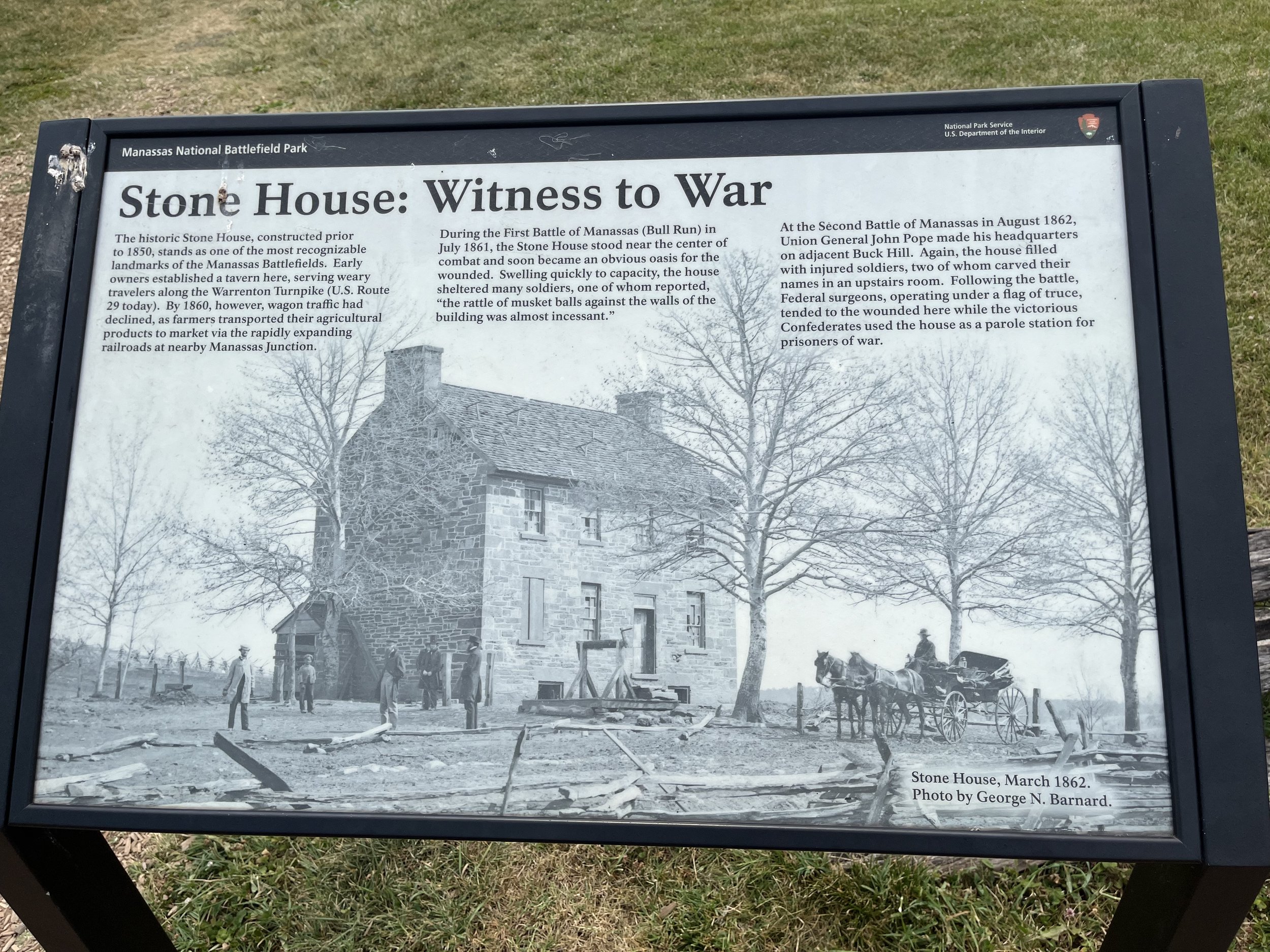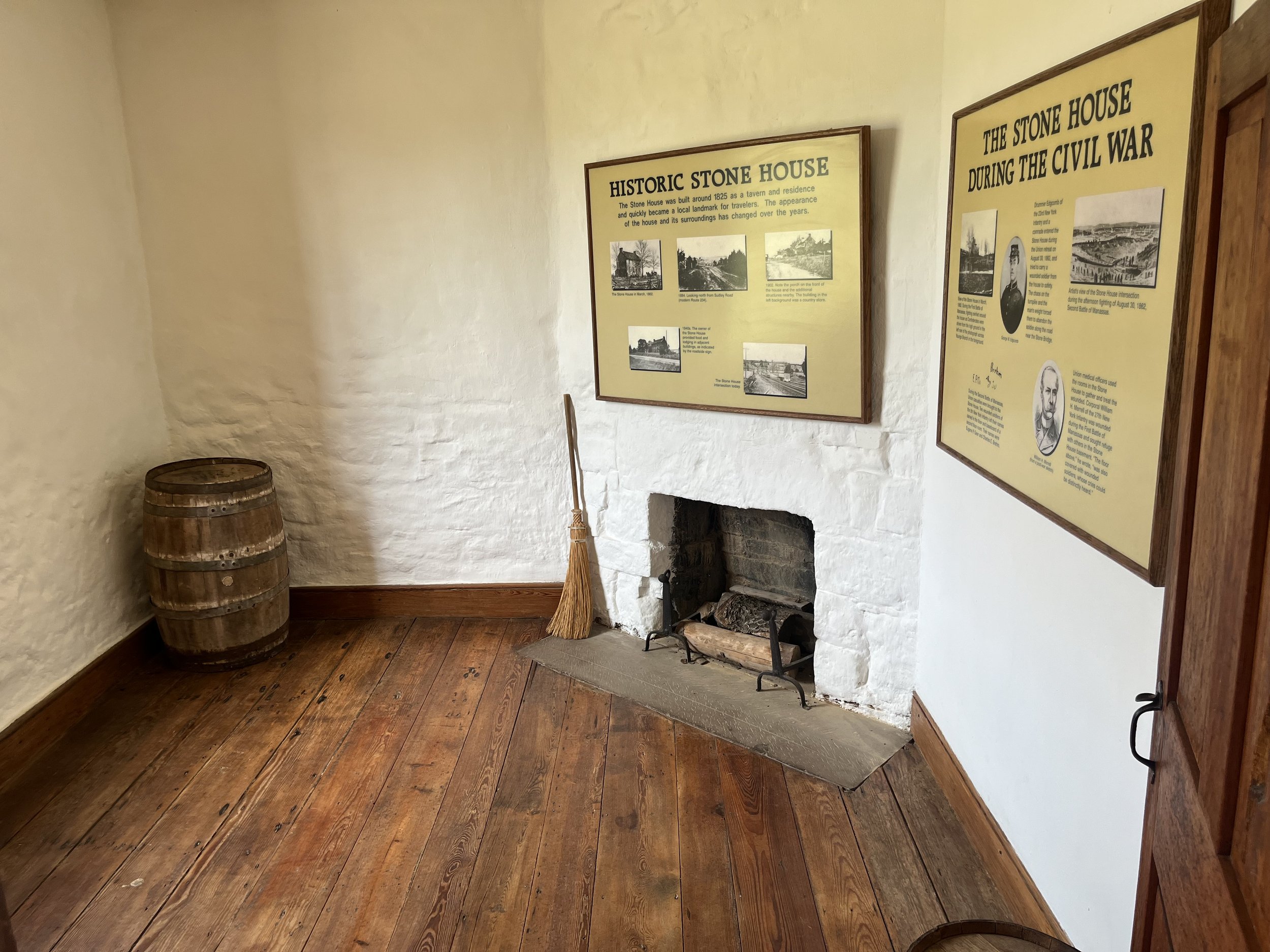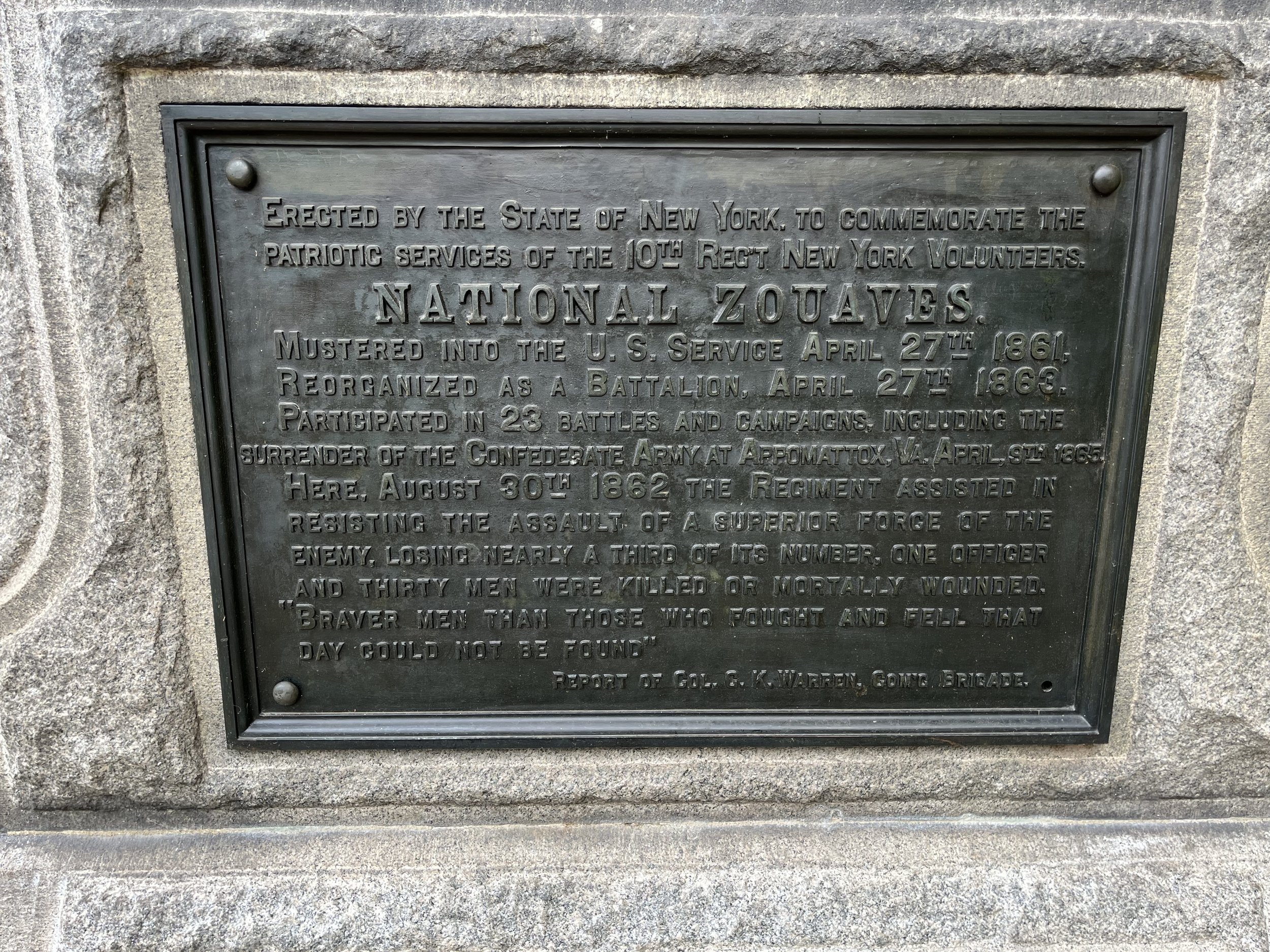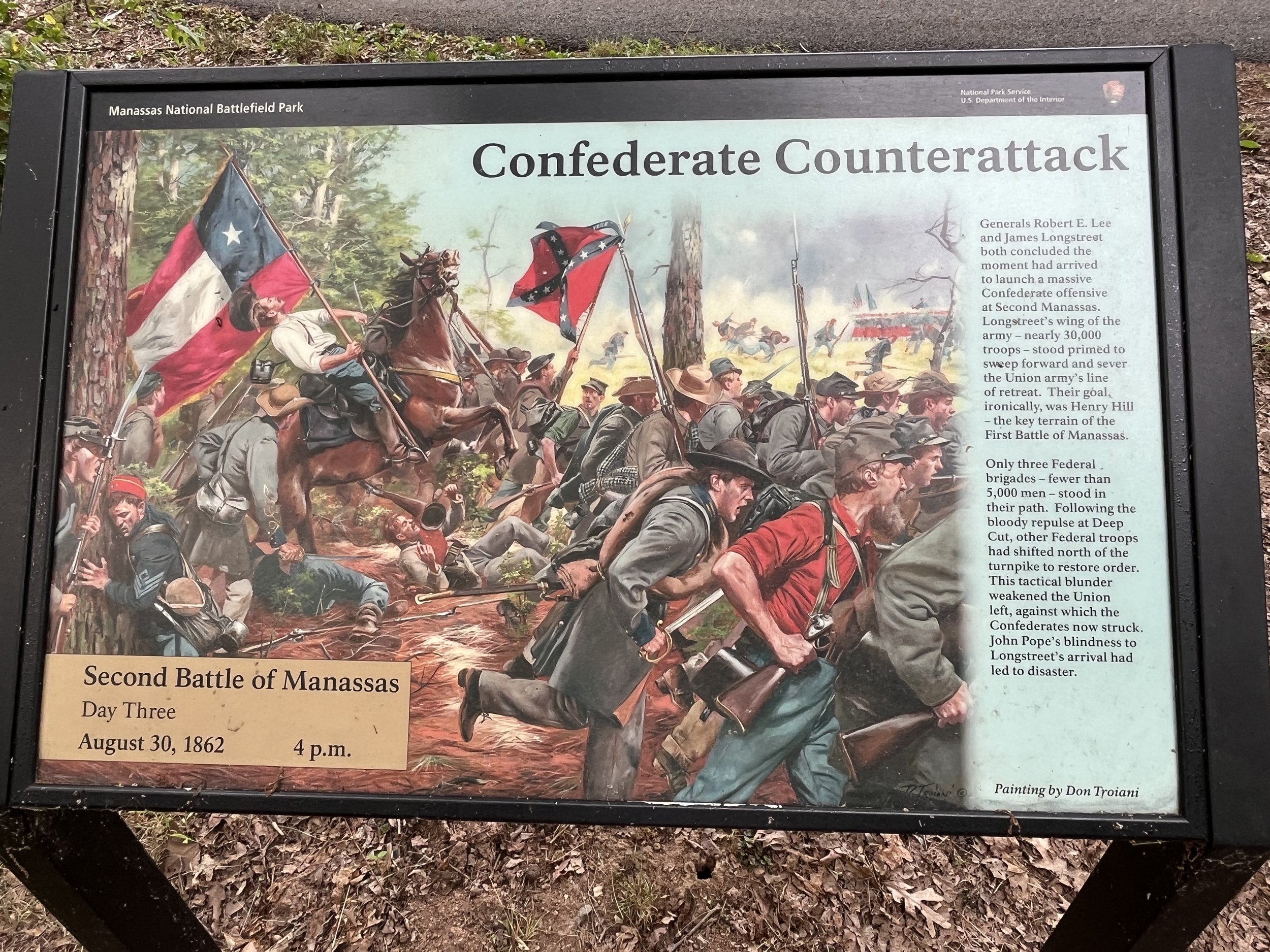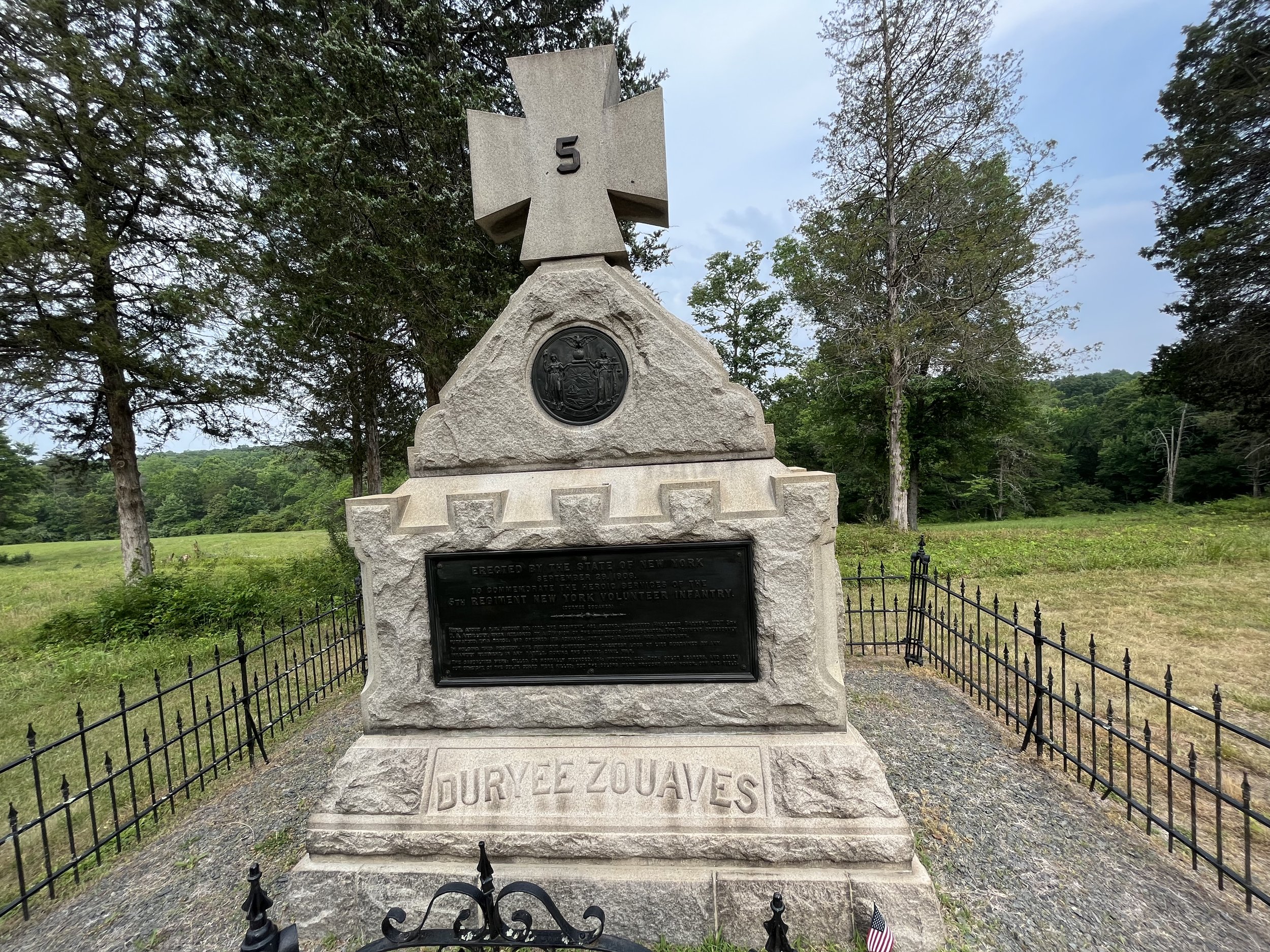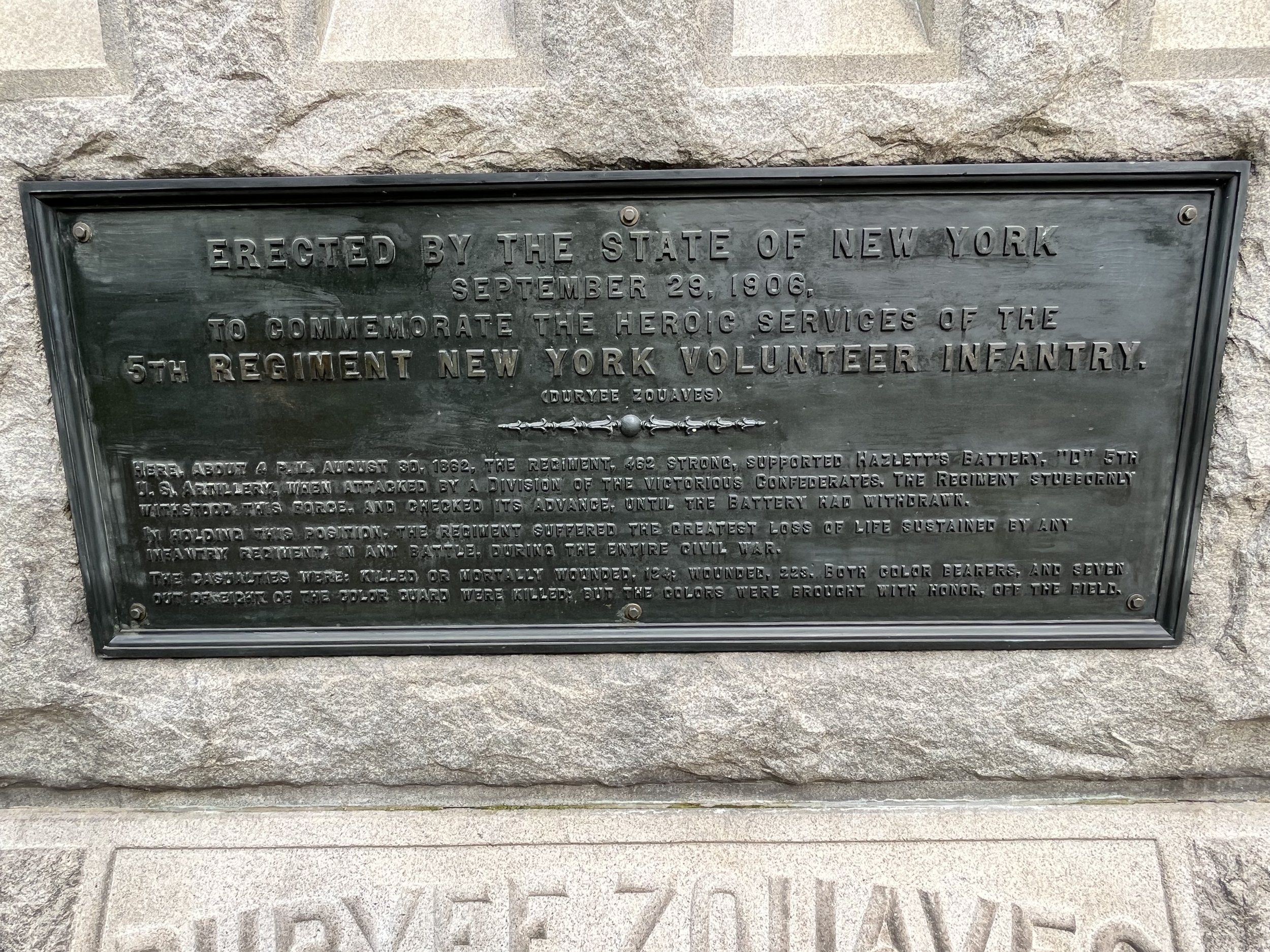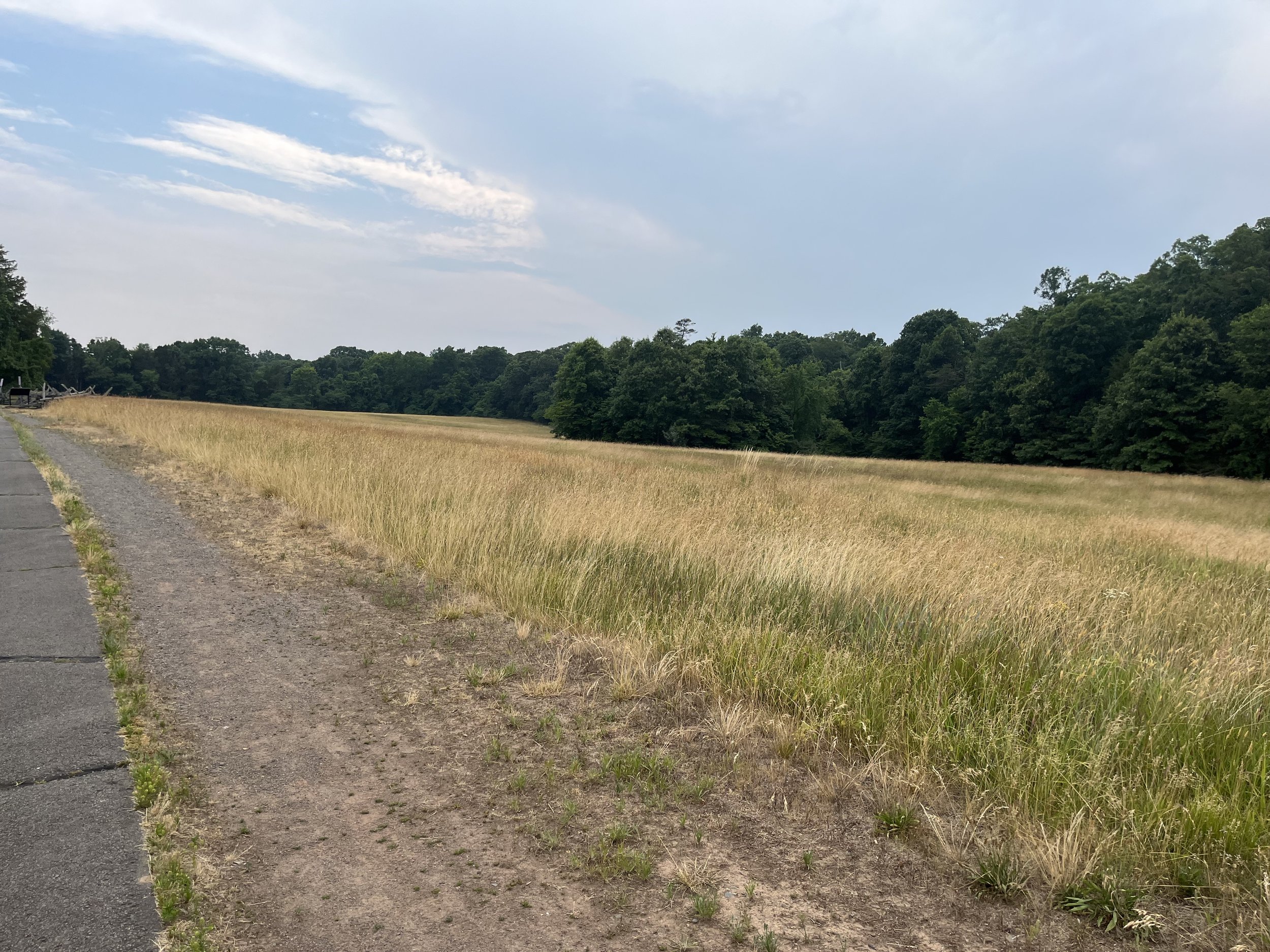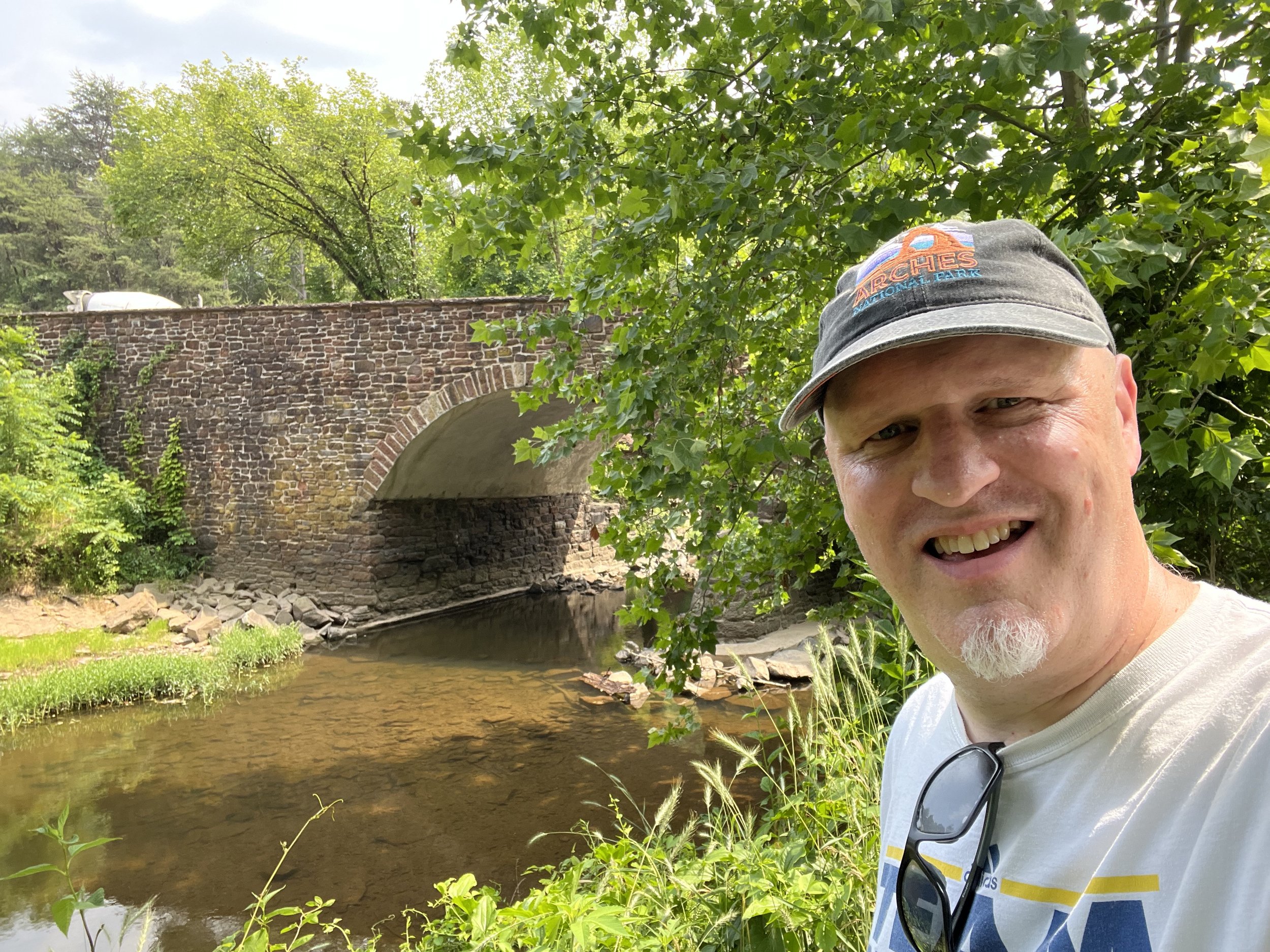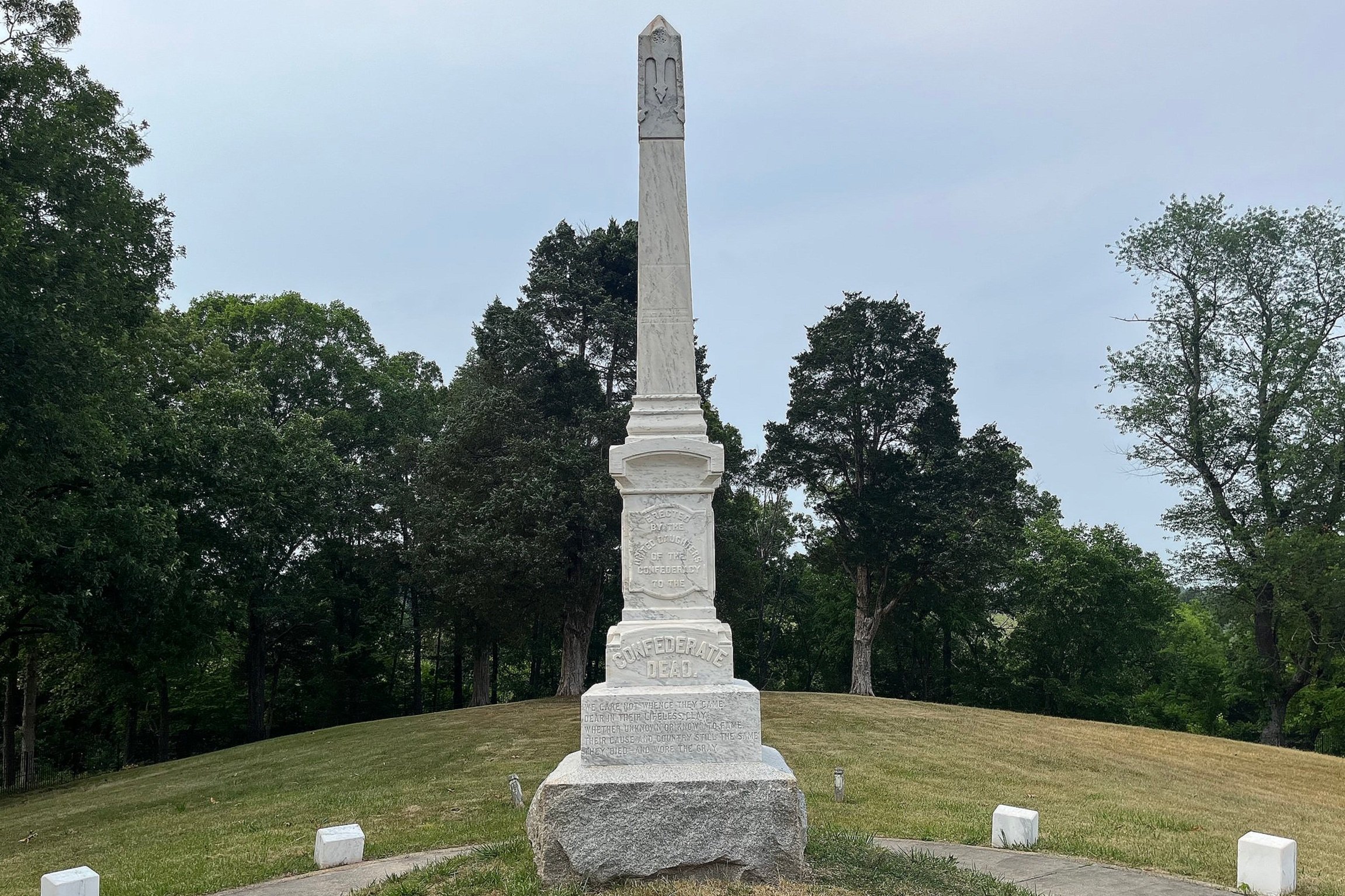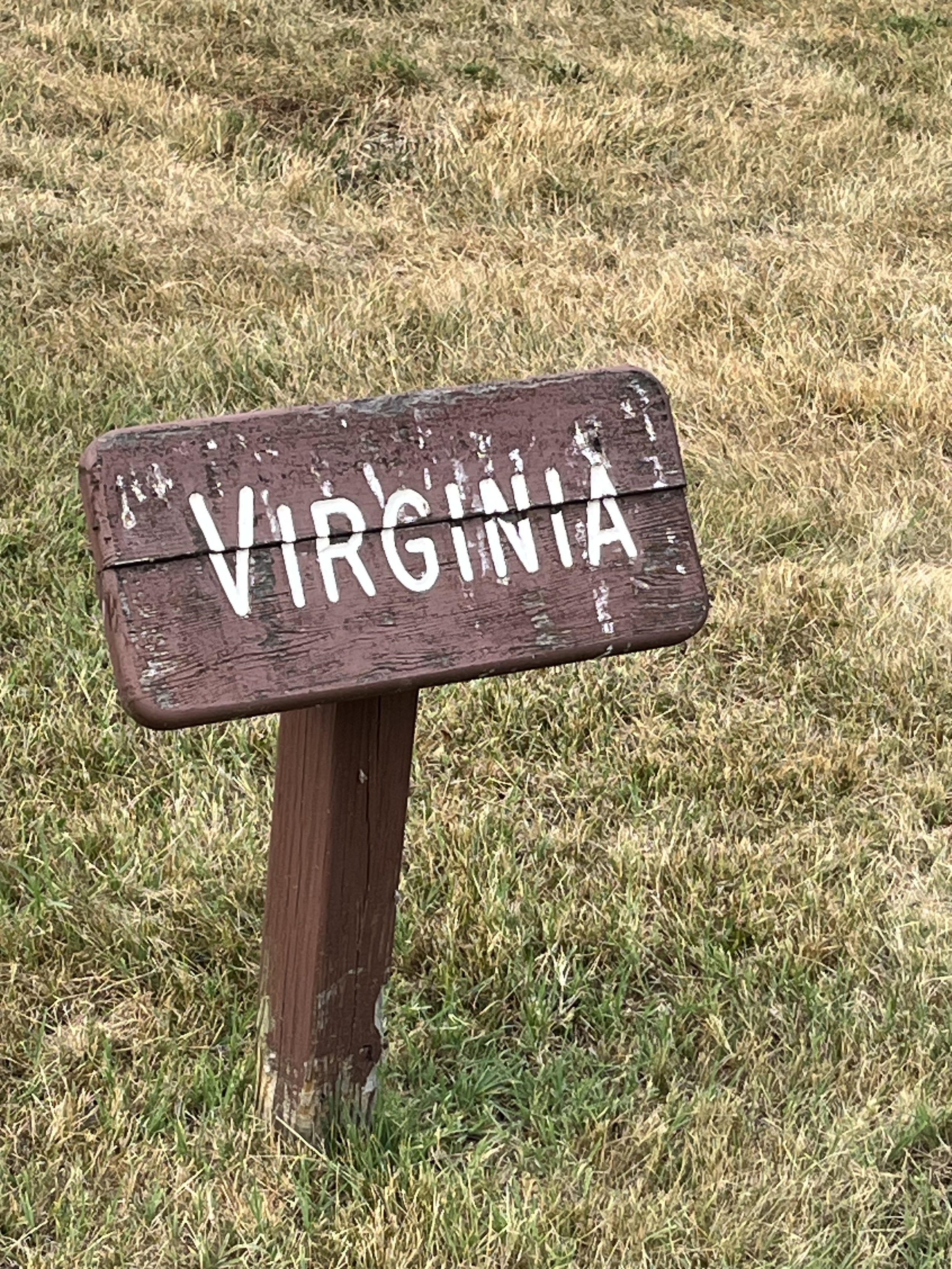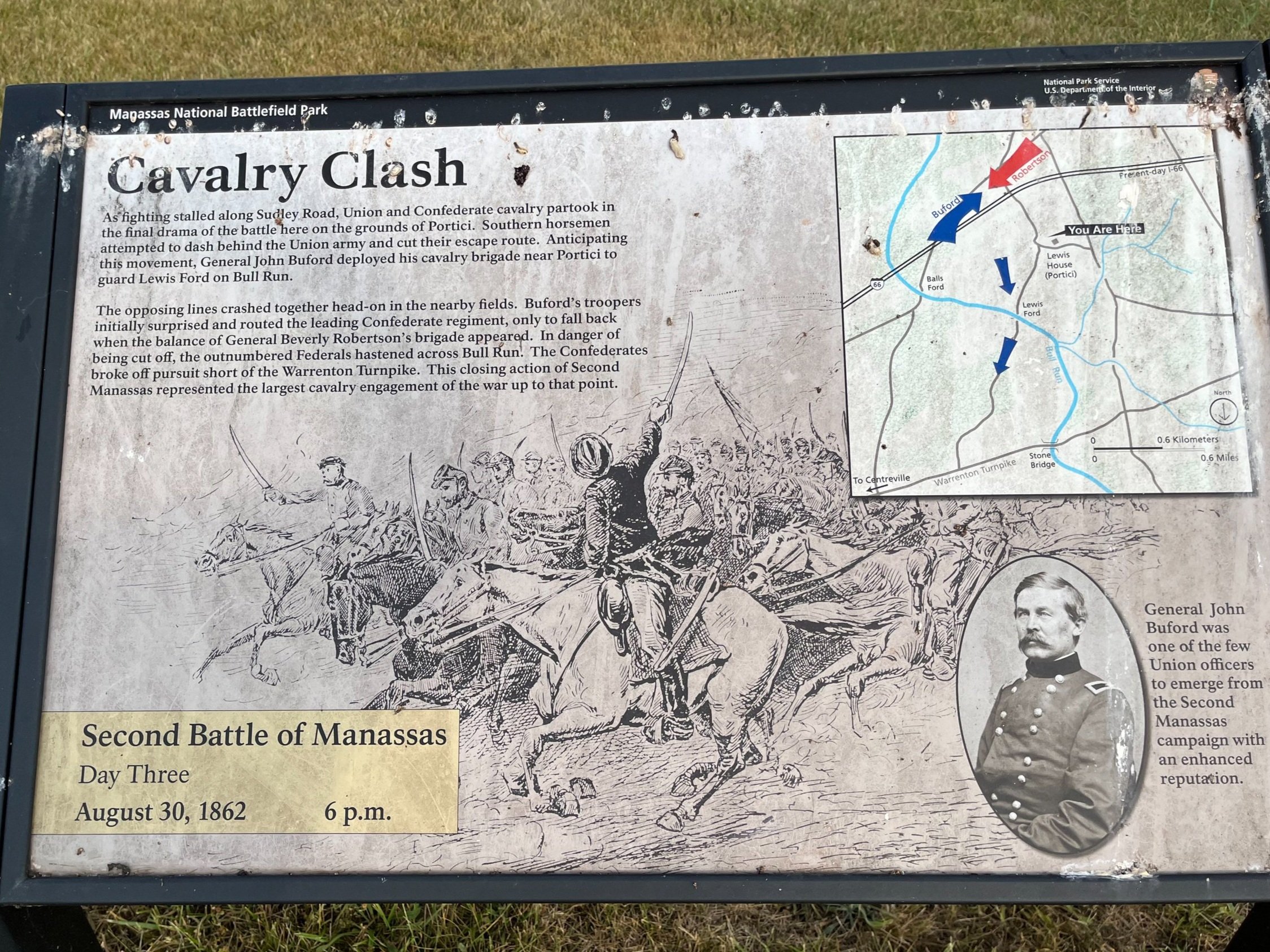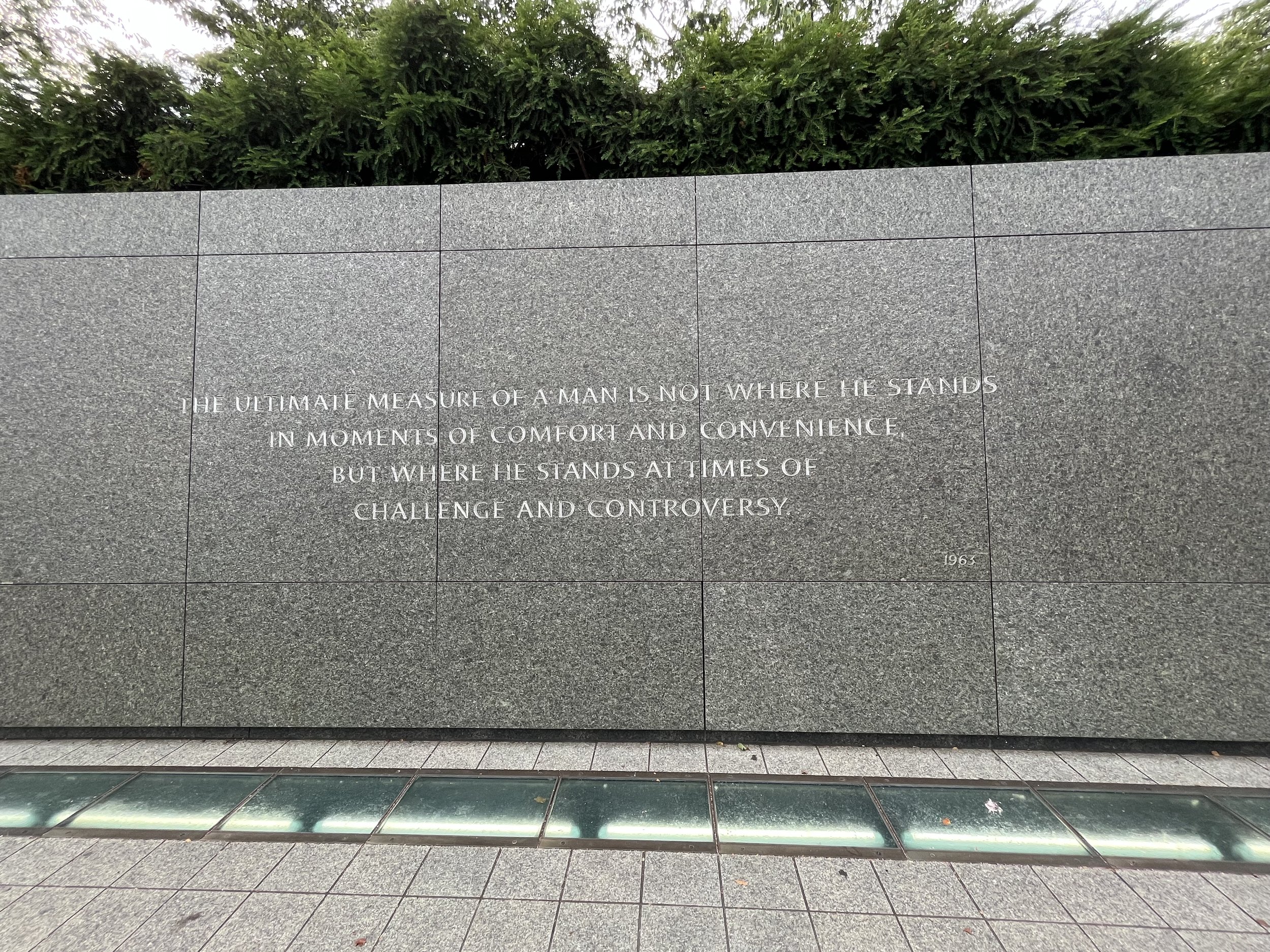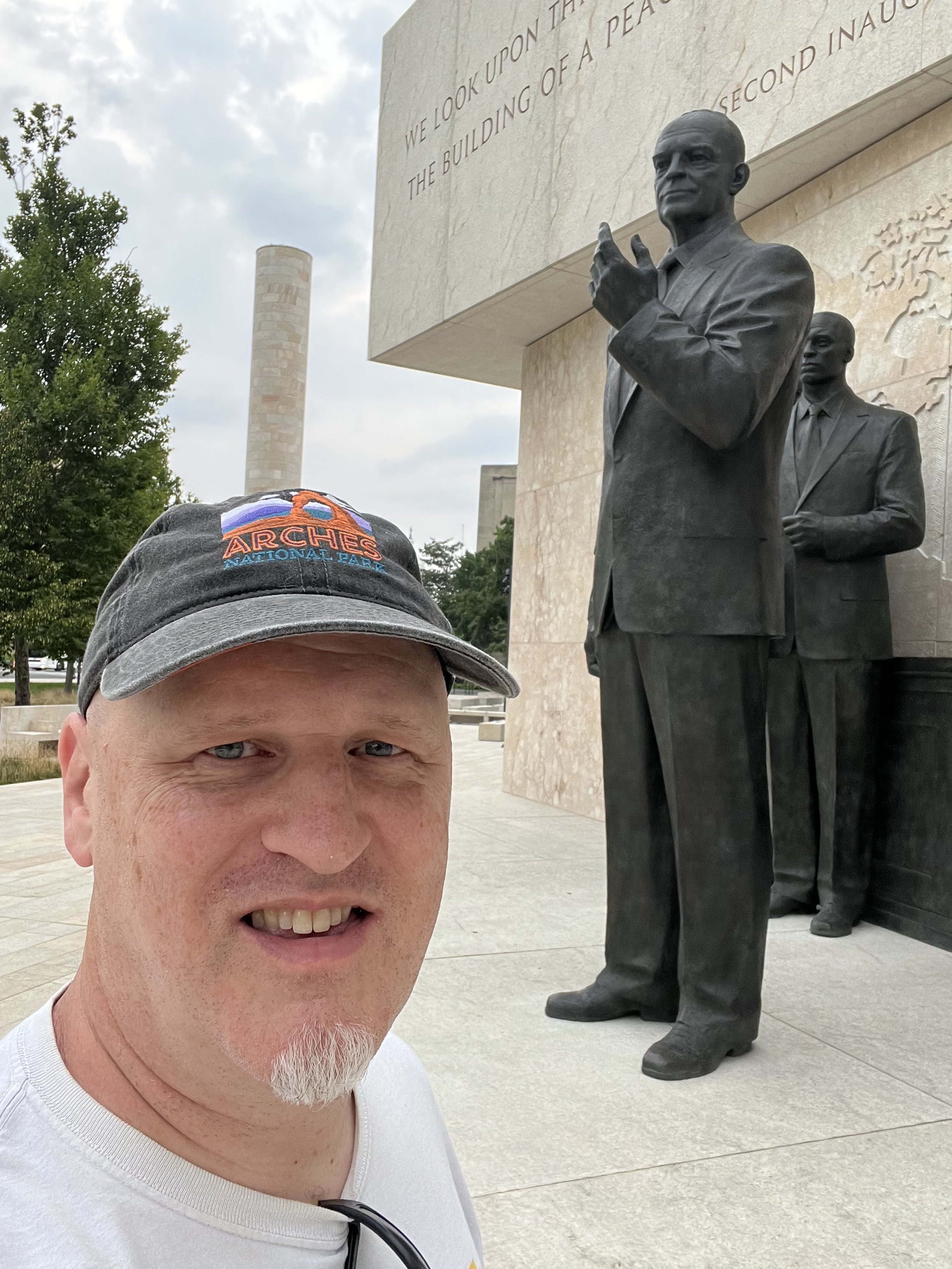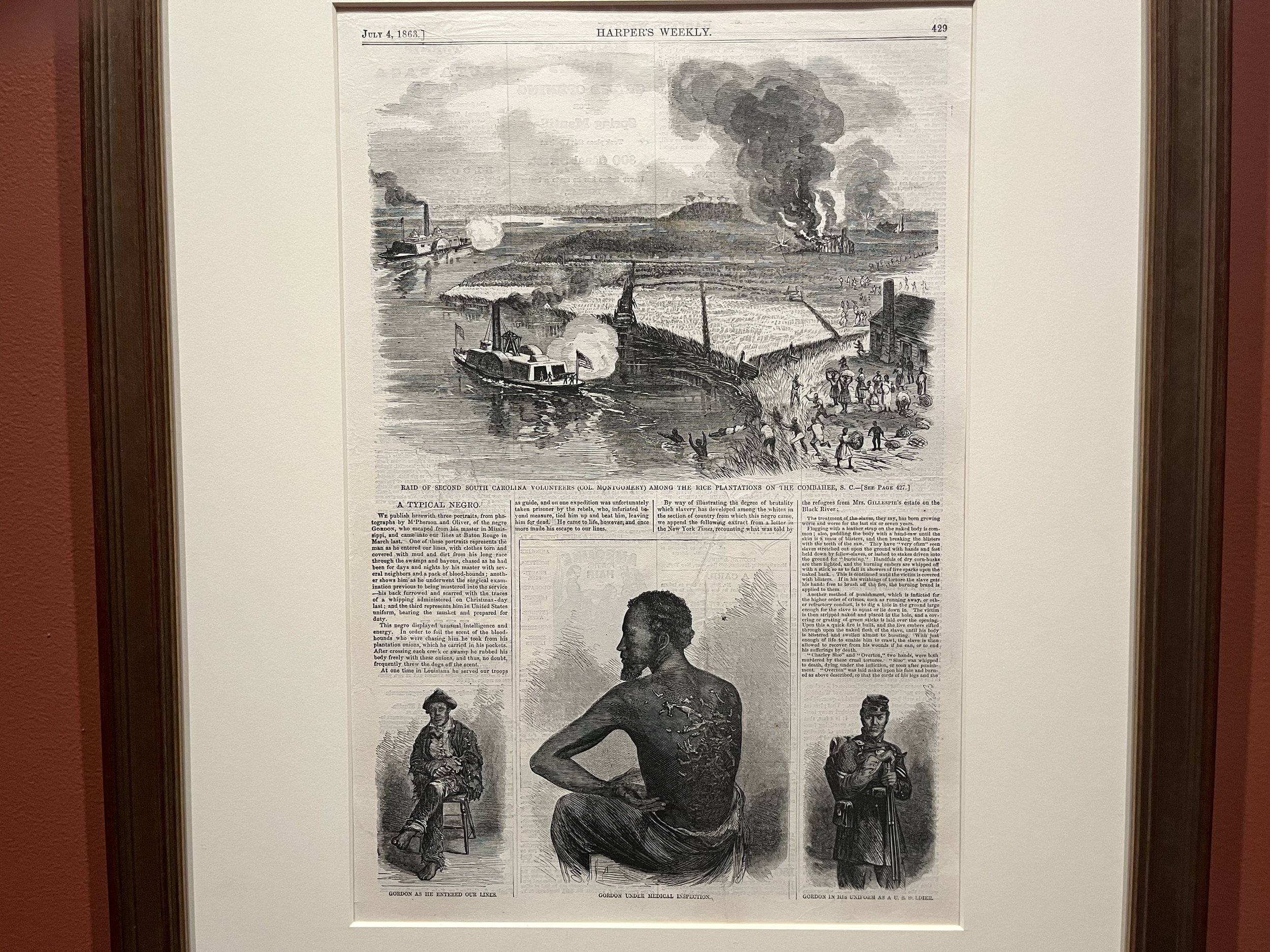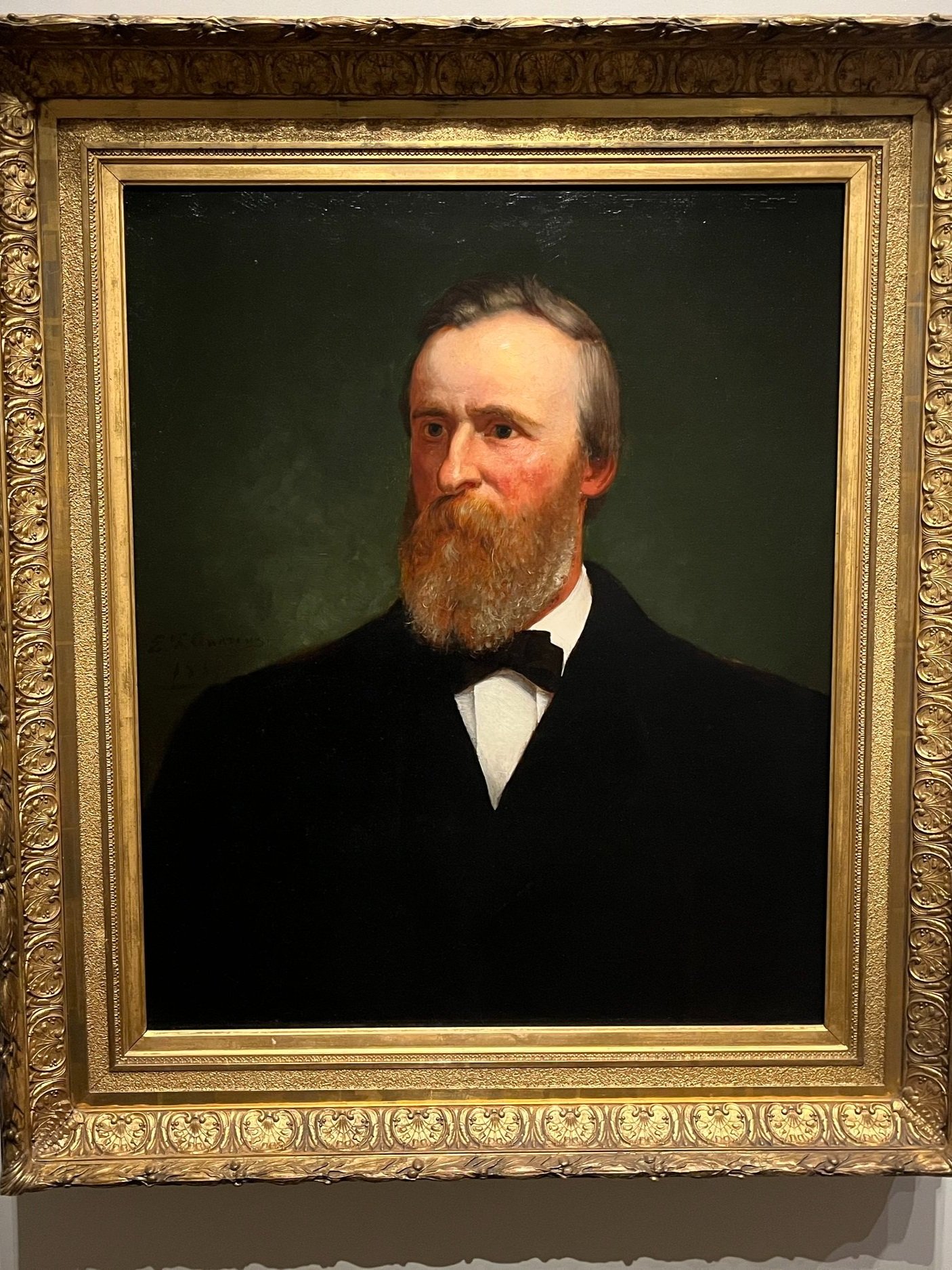A Visit to D.C.! Manassas National Battlefield and much more...
I’ve been to Washington D.C. many times over the years. My brother went to law school at George Washington University, I have family in Virginia Beach and I still have friends in D.C. My son Tony’s girlfriend lives there so we made a little road trip there so he could see her before he heads to Alaska for the summer and I could see some friends and some sights!
I’ve seen a lot in D.C. but there is still a ton more I need to see so I was really indecisive about what I should do. I’ve been itching to get back to Chancellorsville but that would have been an extra 3 hour round trip, so I thought why not Manassas - it’s only 30 minutes from where I was staying and I could just spend an hour or so focused on the 2nd battle and leave.
I spent SEVEN hours there.
I should have known better. I’ve never been able to spend the time I really want to at any single battlefield. I’ve always been on the way to somewhere else or just with limited time on whatever trip I was on. I hadn’t really been to Manassas National Battlefield (I don’t think) since 1986 - I kinda drove past/through it once since in 2008 but I wasn’t able to stop. In 1986 I was with my both of my brothers and after doing the little walking loop on the first battlefield I think they were ready to go. We drove to a few stops on the 2nd battlefield and I remember jumping out of the car to run to a few different spots to see what I could before we left.
What is really remarkable is how much the battlefield has changed since I was last there and that’s really what lured me to stay. If you haven’t studied or read much on the Civil War here’s a little context: Yes TWO important battles were fought at Manassas aka Bull Run - the North generally referred to battles by the closest river/creek/water in general while the South referred to them by the closest town. The two battles were fought a little over a year apart - why at the same spot? It’s a railroad junction - if you can gain control of it in a strategic spot geographically you can control supply lines and gain a big advantage.
1st Bull Run
Most of the significant changes I encountered were related to the second battle and we’ll get to those in a minute - this post may seem a little out of order but stay with me.... The first battle was the very first organized battle of the Civil War and many thought it would be the only battle. Spectators actually came to watch and people thought the outcome would determine….well what I’m not sure. I’m not sure why anyone actually thought the winner of the battle would either preserve the union once and for all or win the Confederacy an enduring independence. The first battle lasted about 12 hours and is a pretty easy narrative to follow on the battlefield. In a nutshell the Union drives the Confederates southward across the battlefield until General Thomas J. Jackson arrives to rally the troops on Henry House Hill and stop the advance to save the day for the Confederates. This is where Jackson earned the nickname “Stonewall” as South Carolina General Bernard Bee gives some variation of the command “There stands Jackson like a stone wall - rally behind the Virginians!” right before he is mortally wounded in the stomach by a Union artillery shell. The visitors center is right by the climax of the battle with the large Stonewall Jackson statue in view. This part of the battlefield is pretty easy to cover in a couple hours. It was the second battle that was MUCH larger and bloodier in scope over a year into the war when the romance of the idea of the war had long since faded. The second battle lasted three days and I wanted to get a better sense of how it went. We’ll get back to the 1st battle a little later.
2nd Bull Run
What I was pleasantly surprised by is that there is now a second visitors center at the Brawner Farm where the opening shots of the second battle were fired. I had never even heard of the Brawner Farm and it was at this point I realized how woefully deficient I was in my knowledge of this battle even though I thought I had a pretty good handle on it. I’ve always maintained as a general rule that you will never understand a battle by reading about it as well as you will after you’ve visited it. I don’t care if you’ve read 20 books on a battle, being there is the only way to complete the picture assuming it’s been preserved, and Manassas has been really well preserved - 5073 acres is protected in the park including 190 acres by the American Battlefield Trust with more ongoing - I even saw some signs showing some areas that the ABT has preserved. My understanding (I could be wrong) is that the ABT has preserved 373 total acres at Manassas and so maybe the other 183 just hasn’t been turned over to the National Park Service and incorporated into the park yet? Often that is how it goes from my understanding. You can also take a walking tour on YouTube with their chief historian Garry Adelman at this link. The visitors center at Brawner Farm is notable for the fantastic electronic map that gives you a perfect overview of the battle and troop movements - I highly recommend this (there is another electronic map at the main visitors center of the first battle). The structure was built well after the battle after the original was demolished and was restored in 2007 with parking and trails. I went on the walking ranger-led tour of this portion of the battlefield and I had the ranger all to myself - a personal tour! This part of the battlefield just isn’t as popular.
Brawner Farm
The fighting on the first day was fierce as troops from both sides faced off only around 30 yards from each other… The result of the day was really Jackson meeting the objective of drawing Union General John Pope into a fight at this location so he could send Confederate General J.E.B. Stuart with the cavalry to bring up General James Longstreet’s army and arrange them into place as the other half of the gaping jaws that General Robert E. Lee would spring shut on the clueless Pope. A masterful plan really.
For those who haven’t studied the war between the states at length I will tell you it’s difficult not to be disgusted with the Union and impressed by the Confederates at various points along the way. Not morally, but militarily. As you follow the story you may go into it pulling for the North so to speak to preserve the union and end slavery (obviously), but you’ll quickly find yourself feeling like the North gets what they deserve on the battlefield when they get whipped repeatedly because so many of their military leaders were complete idiots. It’s hard to admire men like Pope, McLellan, Ambrose Burnside, Joseph Hooker - personally I think Sherman is overrated & Sheridan is awful as well…and even Grant while getting credit for putting the pressure on Lee down the stretch and ending the war was no military genius. On the flip side you have strong military leaders such as Lee, Jackson, Stuart, Patrick Cleburne, Longstreet, Joseph Johnston, the young artillery superstar Major John Pelham, even an evil man like Nathan Bedford Forrest - you can rightfully hate him but unfortunately he was a brilliant general. And while the Confederacy and their institution of slavery is sickening you should also be sick at the Union incompetence that allowed this war to drag on for as long as it did.
Okay back to the battle…
*NOTE: This website is optimized for mobile, but these posts tend to be best viewed on a laptop or desktop party because the captions tend to get cut off sometimes on mobile. You can also enlarge the photos by tapping on them.
The Struggle at Deep Cut
Another new feature at the battlefield is at the Deep Cut. The unfinished railroad that Stonewall Jackson used for his line of defense had to be graded differently along the different features of the terrain for a flat path for the tracks. If there was a rise in the land they had to dig a cut through it, and if there was a dip they would have to build it up. Some of the bloodiest fighting of the battle happened at Deep Cut and I took another walking tour with a volunteer guide across the field where General Pope ordered a huge assault on day 3. Pope wanted to beat Jackson desperately for several reasons: 1) Because he was Stonewall Jackson (the most famous general in the country at this point as our guide put it) and Pope wanted a piece of him 2) Jackson’s men consumed what they could and then destroyed what was left of a massive Union supply depot at Manassas Junction, partying their butts off eating and drinking to their hearts content on August 27th the day before the battle started - Pope is pissed. And 3) Union General George McClellan had just gotten his Army repulsed badly by Lee in the Seven Days Battles trying to take Richmond. Pope and McClellan hated each other. Pope is in command of a new army cobbled together by troops who had also been losing badly to Stonewall Jackson prior to the Seven Days Battles in Jackson’s masterful Shenandoah Valley Campaign. Pope would love nothing better to get a big victory after McClellan’s big defeat. Indeed, McClellan was nearby with his army and didn’t come to Manassas to help Pope disobeying direct orders to do so, sitting in place chuckling to himself about Pope’s certain defeat and the massacre that went with it - McClellan was a joke.
Pope is convinced Jackson is going to retreat from the battlefield (partly due to confusing intelligence) and orders attacks throughout day 2 on Jackson’s line but is unable to sustain a significant break through. At one point they broke through Jackson’s line and none other than what was left of the old Stonewall Brigade that saved the day over on Henry House Hill a year earlier plugged the gap.
Even though Jackson repeatedly beat back Pope’s assaults on day 2 he’s still convinced Jackson is retreating and orders more attacks on Jackson’s line along the unfinished railroad. When Jackson’s men clear out the skirmishers Pope thinks okay time to go all out and orders a massive assault led by New Yorkers against the Deep Cut. The last time I was at the Deep Cut in 1986 you couldn’t really get a feel for the terrain because it was all wooded, but in the years since they have cleared away the trees there to restore that scene to the way it was. Much of the battlefield had clear sight lines all over the rolling farmland in 1862 and that isn’t the case with much growth around the park, but this was a big change at Deep Cut at least from my first visit.
One story our guide told was that of Colonel Edward Frisby, commanding officer of the 30th New York who rode his horse out into the open field to lead his 341 men shortly after 3:00pm on day 3 right by the path we walked. He was hit with a bullet to his jaw and a Major Chrysler yelled “Colonel you are hit!” to which Frisby yelled back and pointed “Major to your post!” and continued on up the hill, where a second or two later he was hit squarely in the forehead and killed. At this point another officer did the same thing and some of the confederates yelled to the others to hold fire - marveling at the soldier’s bravery. Some didn’t fire. Some did and killed him too. The New Yorkers continued to charge towards the Deep Cut where all kinds of carnage took place including the Confederates running out of ammo and throwing rocks. It was at this point in the battle that Lee sprung the jaws on Pope with Longstreet launching a massive counterattack with an army that Pope didn’t even know was on the battlefield and almost completely annihilated Pope’s army. Let’s get to some more pics:
The notes I took on my phone about the Lousiana Brigade’s view is the following: “View from Louisiana brigade across the field towards the road - the deep cut gives way to an embankment at this spot because the ground dips away and has to be built up to keep the level grade of the railroad - so the Louisiana soldiers are behind the embankment instead of in the trench of the Deep Cut. New Yorkers are up against the embankment and to the Louisianans left the Alabamans swing around a bit perpendicular to the confederate lines firing into the union soldiers - slaughtering them” There are also points along the Deep Cut where it’s too deep to be effective IN the Cut so some Confederate soldiers positioned themselves in front or behind it.
Further along Jackson’s Line towards his left flank
The next few photos are further along the Confederate lines on the unfinished railroad to the left flank:
Buck Hill / Stone House
Here we get into a little overlap between the two battles. Buck Hill is where Union General Pope established his headquarters looking Northwest for the 2nd battle, but looking Southward we are in the middle of the Union advance towards Henry House Hill in the 1st battle. The Stone House is still standing - a witness to both battles! It wasn’t open the last time I was at the battlefield and this time I got to go inside. The ranger working there was an intern from my hometown of Farmington Hills, Michigan! What are the odds of that?
Henry House Hill
Henry House Hill was where the climax of the 1st battle took place and also ended up being the site of the Federals last stand to buy just enough time for the army to escape total annihilation. Most of the markers / statues / monuments in this area right by the main visitors center pertain to the first battle.
As for the Stonewall Jackson statue my thoughts have evolved over time on this. It’s complicated. I try to think of the following analogy: As a Jew if I were to go to Africa and visit the battlefield of Kasserine Pass and I saw a statue of Erwin Rommel (Germany’s top general in WWII) there I don’t think I would be offended or upset. Rommel was a general - a military man - not a political idealogue. His motivation wasn’t to help complete the “Final Solution” of the Holocaust. Did he wear a swastika on his uniform? Yes. Am I a “fan” - as in do I like him? No. Was he great to Jews in Tunisia for example? From what I’ve read, no. Am I an expert on Rommel? No. Am I fascinated with the history he’s a part of and ultimately him as a general? Yes. Might my feelings and views on him evolve? Yes. Was he a Nazi? Well, yeah as a general, but he was also involved in a plot to assassinate Hitler that ultimately cost him his life so he obviously wasn’t a lifer in that regard. Like I said, it’s complicated. Was Jackson a slave owner? Yes. Do I like that about him? Obviously no way. Am I fascinated with him as a general as someone who is fascinated with the Civil War? Yes. A statue of Jackson was removed from Monument Avenue in Richmond a couple years ago - I’m okay with that. There’s a difference in my opinion between a statue designed to commemorate and celebrate the leaders of the “Lost Cause” of the rebellion (the idea that the South was right and virtuous in their secession to maintain slavery, their way of life and their states’ rights) in some random plaza, and a statue ON a battlefield that historically commemorates what happened on that spot. People argue the sides of the monument debate in very simple terms which frustrates the hell out of me. I don’t have a problem with a statue of Stonewall Jackson on the Bull Run battlefield. But would I protest if they decided to tear it down? Actually no. It was completed in 1940 - it wasn’t always there. It doesn’t HAVE to be there - and it is huge. I do have a problem with a statue of Robert E. Lee in New Orleans which he had virtually zero personal connection to if it was erected to celebrate the Confederacy by racist idiots. Tear it down (which they did). That’s a case where we aren’t erasing history, we are erasing the history of idiots who took the worst aspects of our history and celebrated it.
Those are my thoughts on the matter (I have plenty more). I think they are objective and reasoned. You’ll see a few pics of the statue below…
Panorama of the Confederate artillery position facing the Federal artillery 300 yards away 1st battle
It’s interesting that the interpretive marker entitled “Like a Stone Wall” above describing the scene of Jackson’s men making their stand and the Bernard Bee monument have different versions of Bee’s quote giving Jackson his nickname. I’ve seen so many versions of it… not to mention that it’s been interpreted as both Bee observing Jackson bravely leading and inspiring his men to hold the line and also as Bee calling out Jackson for standing frozen and not doing anything. Obviously the flattering version stuck and it seems the most likely to me because he was also quoted as saying in response to being informed that they were being driven from the field “Then we will give them the bayonnet!” which doesn’t sound like indecisiveness. Plus we know Jackson went on to become a great general.
Poor Judith Henry born in 1776 became the first civilian casualty of the war when her home was caught in the crossfire. The original house was destroyed by the end of the 2nd battle. A renovated version now stands where the original was, and the “companion” monument I guess you could call it to the Groveton monument by the Deep Cut was dedicated on June 11th, 1865 as one of the final acts of the Union soldiers there before their discharge.
2nd Bull Run - Day Three - Confederate Army Jaws Snap Shut on Pope
So getting back to 2nd Bull Run… we left off earlier with Jockson’s men along the unfinished railroad repulsing the New Yorkers at the Deep Cut and running out of ammo. When Longstreet’s army launched the counterattack once again it was New Yorkers who took the brunt of the surge…
Chinn Ridge - 2nd Bull Run
Moving right along let’s get back to the 2nd battle and close it out. An impossibly outnumbered Union force tries to defend Chinn Ridge so a rear guard can be organized on Henry House Hill and allow for a retreat - an escape from the battlefield. The narrator from the electronic map said at this point Pope had to choose not between victory or defeat but defeat or annihilation. Pope would eventually try to blame some scapegoats - notably General Fitz John Porter whose career he ruined (President Chester Arthur eventually reinstated him). There’s a nice paved path that takes you along the ridge (I don’t remember if this was there in 1986), they are continuing to preserve and rehab this portion of the battlefield and here’s a detailed map of this part of the battle.
Stone Bridge, Groveton Cemetery & Portici
A few more spots to cover are the Stone Bridge which was the bridge the Union soldiers used to retreat from both defeats (it’s been rebuilt to it’s wartime appearance), the Groveton Cemetery which contains the remains of about 500 Confederate soldiers - only two are identified, and Portici which was the site of the Confederate HQ for the 1st battle and a final cavalry clash at the end of the 2nd battle.
All in all a fantastic and educational day - I have a much better understanding of how the 2nd battle of Manassas was fought. Highly recommended.
MLK & Eisenhower MEMORIALs
I headed back to D.C. after the battlefield to see two major memorials I hadn’t seen yet, and MLK in particular was a great spot to be since it was Juneteenth. It wasn’t that crowded and the MLK statue was bigger than I anticipated - majestic really and a fitting tribute to the man. The Eisenhower Memorial seems to be a little under the radar (?). It opened in 2020 so it’s the newest memorial at the national mall and it celebrates both his accomplishments as Supreme Commander of the Allied Forces in Europe during WWII as well as the 34th president.
Blair, Lee and Decatur Houses
I went to the White House the following morning just to get an up close look which I hadn’t done before and just as I got there they ordered everyone to clear out of the area by the fence on the edge of the lawn. I don’t know why but apparently that happens all the time for various reasons (?). But while I was there I happened to look up and notice I was standing right in front of the Blair House. I’ve read about the Blair House plenty and we just learned on our western roadtrip that Harry S. Truman lived there for a good part of his presidency right across the street from the White House when his daughter Margaret’s piano almost came through the 2nd floor of the White House and he demanded that it be renovated. I didn’t realize it was also the house where Robert E. Lee was offered and declined command of the Union army at the beginning of the Civil War. In 1943 it was combined with the Lee House (no relation) to become the president’s guest house. The Decatur House is also on this block right on Pennsylvania Ave next to Lafayette Square - so much history! Henry Clay and Martin Van Buren both lived here.
The National Portrait Gallery
After a visit to the Renwick Gallery which is a Smithsonian Art Museum right next to the Blair House I went to the National Portrait Gallery and……wow. I can’t believe I’ve never been to this place. It’s incredible. Every time I go to an art museum I find myself drawn to portraits of notable people and this is a massive museum of all portraits of prominent figures in American History. I didn’t realize how amazing this place would be and did not allow myself nearly enough time to explore it. I have to go back… But I did take a few photos of some of my favorites that I did see including some presidents from the permanent gallery of presidential portraits. Here are just a few but you can also see them on their website. Let’s start with the Williams sisters who are honored along with several others for the Portrait of a Nation series honoring individuals who have made transformative contributions to the United States! These portraits of Serena and Venus are stunning…
Beautiful, powerful, BAD ASS Serena!!!
Such a cool “dual portrait” of the stunning champ - Venus!
Historical Figures
First we’ll do a few historical figures before we get to a few of the presidents. Take Daniel Webster for example - we just discussed his son Fletcher earlier who was mortally wounded at 2nd Manassas. One of the “Big Three” dominant senators of the 19th century along with Henry Clay and John C. Calhoun, his story is a complicated one that represents some of the complexities of the times - he was anti-slavery and put his money where his mouth was by purchasing the freedom of several individuals, but also supported the fugitive slave act of 1850 as a compromise to save the union… I had never seen this likeness of him as a young fiery congressman painted in 1835. The way they present these portraits with these concise bios next to the portraits is just perfect.
The stories of two men named Peter and Gordon who escaped from slavery were conflated by Harpers Weekly and the photos (especially the one of Peter’s horrific scars) became very well known at the time causing righteous outrage with such photographic evidence of the horrors of slavery. Some of the portraits in the gallery are not just paintings but also original prints. I’ve included the close up photos but I also included one with the whole frame so you can see that they are pretty small, along with the whole story of these series of prints.
I could go on and on with the portraits but you get the idea… visit the website and better yet visit the gallery if you can! Here are a handful of the presidential portraits I really like - not necessarily based on which presidents I personally like the most as presidents per se but just a handful of the portraits that I like.
U.S. Presidents
A few notes on the George Washington portraits. The Lansdowne Portrait (the full length one) has three original copies made by the artist Gilbert Stuart. We just saw one of them which is on display at the Brooklyn Museum. The one at the National Portrait Gallery is the original and it was acquired in 2001 - they purchased it for 20 million. The unfinished one known as The Athenaeum Portrait was also done by Stuart and purposefully left unfinished to be used as a model for other portraits. The Rembrandt Peale painting of an aged Washington was done when Peale was 17 and makes Washington look older than he really looked apparently - the original is in the possession of the Pennsylvania Historical Society and the two known copies are this one at the National Portrait Gallery and right here in Detroit at the Detroit Institute of Arts - it’s been my favorite portrait there for years and I was pleasantly surprised to see the other copy in D.C.
Last stop on the way home was at the Monocacy National Battlefield which I’ve visited before here’s another battlefield which will require a return trip. They’ve built a fantastic new visitors center and have continued to develop and interpret the battlefield since the last time I was there… I snapped a quick photo of the spot where the battle began - I hope to get back there to spend more time.
So there you go - another whirlwind roadtrip packing in as much stuff as I could in just a couple days. I didn’t title this one “Road Trip!” because the sights were all D.C. related… it was really a trip to the D.C. area. So far my “Road Trip” posts have included lots of stuff along the way in the true “road trip” aesthetic lol… I hope you enjoyed this post!
M10 Social is owned by Doug Cohen in West Bloomfield, MI and provides social media training and digital marketing services from the Frameable Faces Photography studio Doug owns with his wife Ally. He can be reached there at tel:248-790-7317, by mobile at tel:248-346-4121 or via email at mailto:doug@frameablefaces.com. You can follow Doug’s band Vintage Playboy at their Facebook page here.
******************************************************************************************
Tune in to the 📷Doug&Ally📷Morning Show T-F between 8:30 & 11 EST UTC-4 on Heckle by following them on Heckle or Twitter at @frameablefaces! Also check out the Doug & Ally Morning Show podcast at anchor.fm/frameablefaces and everywhere you listen to podcasts! Doug also tweets at @dougcohen10 and @M10Social!
